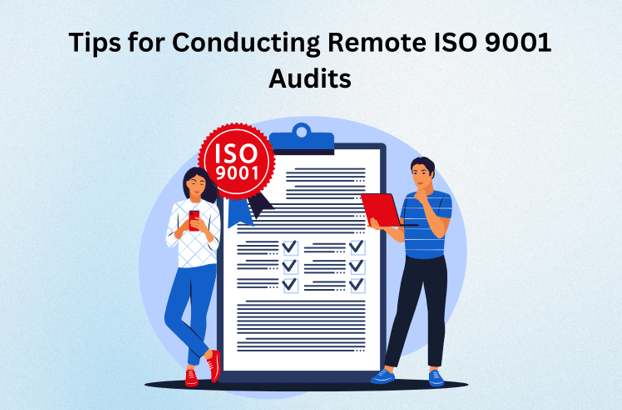Tips for Conducting Remote ISO 9001 Audits

Performing audits remotely is becoming more prevalent, and there are difficulties and challenges. This blog provides a few essential pointers on conducting an ISO 9001 Audit remotely. If you have an ISO 9001 Qualification, use this blog to better understand the essentials of ISO 9001 Audits.
Table Of Contents
- How to Conduct ISO 9001 Audits Remotely?
- Conclusion
How to Conduct ISO 9001 Audits Remotely?
Use Reliable Technology Platforms
To carry out remote audits, choose dependable and secure technological platforms. Video conferencing, document sharing, and collaborative software are widely used here. These allow you to meet virtually, share files, and converse in real time. Choose the technology easily accessible to all participants and familiar with.
Schedule Pre-Audit Meetings
Meetings should be scheduled with appropriate individuals, auditees, and auditors before the audit begins. This will clarify everyone’s expectations, go over the audit timeline, double-check the IT needs, and answer any questions or issues that may arise. A pre-audit meeting is helpful to ensure a productive and trouble-free remote audit.
Establish Clear Communication Channels
The remote audit communication should be clear and compelling, ensuring participants are well-informed about the process, procedures, timing, roles, and expectations. Give them your contact details so they can provide security instructions. For assessing audit papers and documents, you can ask them to share them before calls or meetings.
Prepare Audit Documentation Digitally
Gather all necessary records, papers, and evidence in electronic form and digitise them for the audit. Securely store and exchange audit documents with other auditors and auditees using cloud storage or a document management system. Before beginning the remote audit, check that all papers are available, current, and easy to navigate.
Conduct Virtual Opening and Closing Meetings
Incorporate online kickoff and wrap-up sessions into your remote audit schedule. In the first meeting, everyone is introduced, the audit agenda is reviewed, and the audit procedures are explained. At the final meeting, everyone gets a rundown of the audit’s results, discusses the observations, gives each other comments, and figures out what comes next, including what needs fixing.
Facilitate Virtual Auditing Techniques
Develop new methods of auditing specifically for use in digital spaces. Video conferencing is a great tool for conducting auditee interviews, observations, and conversations. During the audit, use screen sharing to examine records, papers, and evidence. Brainstorming, data analysis, and visual presentations can all benefit from virtual whiteboards or collaboration tools.
Ensure Data Security and Confidentiality
Protect the privacy and integrity of sensitive information when conducting audits remotely. To keep sensitive information safe, use encrypted channels for communication, use platforms that encrypt documents, and implement access controls. Participants should be reminded to follow privacy policies and regulations and not disclose sensitive information in insecure areas.
Conduct Thorough Document Reviews
Ensure that all documents are reviewed thoroughly throughout the remote audit. By analysing the policies, procedures, and documentation, you can determine and compare them with ISO 9001 standards. Then, verify that the document is up-to-date and accurate. Every document needs to be verified to comply with all organisational policies and goals.
Collaboration and Engagement
Ensure all audit participants work together and actively participate in the remote audit. The audit stresses the need for open dialogue, involvement, and honesty. Encourage cooperation between auditors and auditees so they can freely communicate, get new perspectives, resolve conflicts, and accomplish audit goals.
Provide Clear and Timely Feedback
Be sure to provide clear and constructive feedback throughout and after the remote audit. Effectively communicate audit results, observations, non-conformities, improvement possibilities, and necessary remedial measures. Provide auditees with direction, suggestions, and assistance to improve their quality management systems and respond to audit findings.
Follow and Monitor Corrective Actions
Monitor the progress made following the audit to ensure everything is back to normal. Also, monitor how far along the road to fixing problems, improving, and responding to audit results are. By offering continuous support and collaboration, you can help auditees stay in compliance with ISO 9001 standards.
Conclusion
Organisations can complete ISO 9001 audits remotely if they comply with ISO requirements. Successful remote auditing experiences require adaptation, teamwork, communication, and the use of technology.





